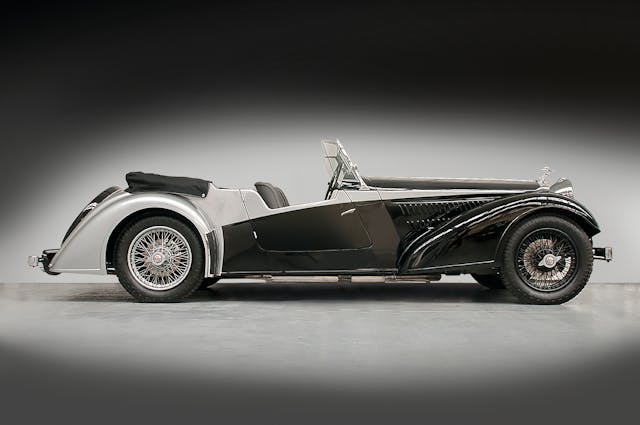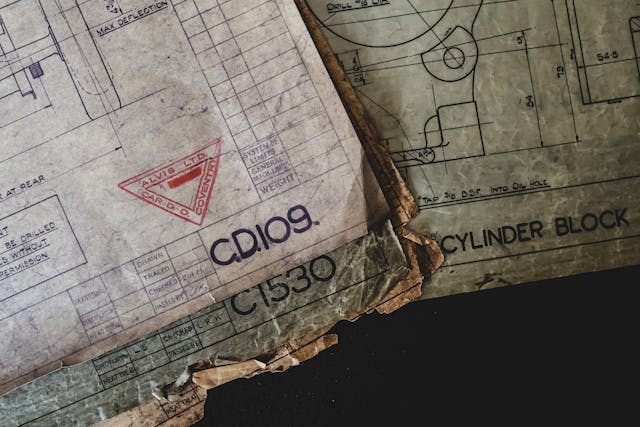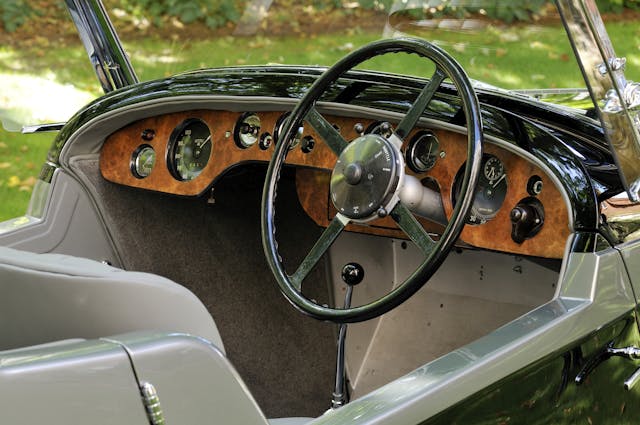Driving a $400,000 Alvis Turned Me into Mr. Toad
“In an instant (as it seemed) the peaceful scene was changed, and with a blast of wind and a whirl of sound that made them jump for the nearest ditch. It was on them! The “Poop-poop” rang with a brazen shout in their ears, they had a moment’s glimpse of an interior of glittering plate-glass and rich morocco, and the magnificent motor-car, immense, breath-snatching, passionate, with its pilot tense and hugging his wheel, possessed all earth and air for the fraction of a second, flung an enveloping cloud of dust that blinded and enwrapped them utterly, and then dwindled to a speck in the far distance, changed back into a droning bee once more.”
Obviously we’re supposed to feel sorry for poor Mole and Ratty in their first encounter with Mr Toad on the road in Kenneth Grahame’s Wind in the Willows, but reading this as a child it was Toad’s thrill ride that enthralled me.
“The motor-car went Poop-poop-poop, as it raced along the road,” he wrote and, right now I can’t think of a better way to describe what’s going on. I am every bit the amphibian automobilist behind the wheel of a no-less magnificent motor-car—an Alvis Vanden Plas Tourer continuation.


Only 25 of these £325,000 ($411,500) specials are to be built, with four other Alvis models also offered as continuation models, using the a three-liter motor or the fabulous 4.3-liter in-line six engine that’s responsible for those splendid poop-poop-poop sounds. It’s perhaps a little noisier than normal today as the car hasn’t had an outing for a few months, but those part-throttle poops add to the charming steampunk experience.
To meet modern emissions requirements the engine has electronic ignition and fuel injection, with a trio of throttle bodies replacing the original carbs. A six-speed Tremec manual transmission is fitted and there are servo-operated Brembo disc brakes in lieu of the cable operated stoppers that would have originally been fitted. Rack and pinion replaces a steering box, but without any form of assistance.
All these modern touches serve to make this Alvis accessible—a reliable and, easy to drive alternative to the dozens of original cars that are also for sale in the company showroom in Kenilworth, near Coventry.


Alvis has been based here since 1968 and, when owner Alan Stote acquired the business and trademark, he also got a warehouse of 400,000 parts, 50,000 engineering drawings and the records of 22,000 cars. Offering service and sales the facility is also where the continuation cars are hand built.
“I bought the company in ‘94 after selling my original business in 1988.” says Stote. “My main interest wasn’t restoring cars, it was the documentation. They documented every car they ever built. I’m not a mechanical engineer, my real passion is the industrial history.”

You can read more about exactly how Alvis goes about keeping its history alive in Ronan Glon’s excellent story but it’s the sensations of the past in the present that’s my focus today.
Just looking at the fabulous aluminum bodywork, draped over its ash frame, is like donning a pair of rose-tinted spectacles. Road works, speed cameras, these irritants of modern motoring matter not a jot as one is transported back to a time when every automobile journey was still an adventure.
The wide-opening suicide doors make it easy to step up and into a driving position that’s somehow both high off the ground, yet relatively low in the car. Another contradiction: the Vanden Plas Tourer is undeniably large, yet the cabin is compact and quite where rear seat travellers are expected to put their legs is unclear as the whole space is taken up with a squishy leather bench. Being open-sided and with the canvas topped stowed away it’s never claustrophobic, but it might be wise to warn your co-pilot that any knee fondling is purely down to the proximity of the gear lever.
The shifter itself is a delight, with a solid mechanical heft to it, combined with easy accuracy. Meanwhile the clutch is light and the brakes have both great feel and stopping power. The accelerator’s a little stiff and has a long action, but suits the torque-rich nature of the engine.
The big six will rev to 4,500 rpm, yet pulls strongly from little more than idle. It’s almost diesel-like in its luggability so there’s no real need to keep an eye on the rev counter. That’s a good thing as it’s positioned, in the lovely walnut dash, directly ahead of the passenger seat and impossible for the driver to see. The speedometer is also mostly obscured by the large, thin-rimmed, four-spoke steering wheel, but you’ll be gauging your velocity directly by the rush of wind through your hair anyway.

Although unassisted, once rolling there’s not too much effort needed. It doesn’t self-center, but it does track every imperfection in the road surface and there’s an initial temptation to correct every little wiggle. Relax the hands, let the front wheels do their dance, and then it all starts to come together.
The chassis is essentially the same as it was in 1937, albeit with modern dampers. There’s flex and scuttle shake, but it absorbs the bumps of British country roads that look like they haven’t been maintained since then.
It’s quite an achievement to maintain so much of the character of a pre-war car, while making it useable day-to-day.
Bravo! And poop-poop!




A magnificent motorcar, indeed, but a the very idea of a continuation Alvis comes close to a fine line that should never be crossed. I have long thought that if there is one marque that should never have a replica produced it is Alvis. After all, what self-respecting gearhead wants to be seen going down the road in an Alvis Impersonator.
I have lusted after an Alvis since I first fell for English cars back in the early 1980s. It’s hard to imagine I will ever manage to own one, but while my friends all had dreams of Lambos and Ferraris this is the stuff I lusted after. The example here is superb, although to my eyes it’s a bit less Mr. Toad and a bit more Cruella DeVille!
Poop Poop? Not pop pop?
Gorgeous cars.
Not according to The Wind In The Willows!